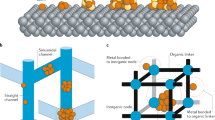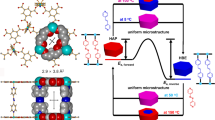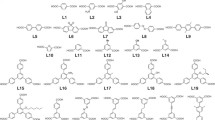Abstract
Metal organic frameworks (MOFs) are a class of porous solids formed by linking metal centres or metal clusters by suitable organic ligands capable of generating porosity in the microporous and mesoporous regimes. They have been investigated extensively for their gas storage applications in the last two decades. Interpenetration is nature’s way of avoiding excessive free-space within the large porous networks by growing identical but independent networks within a parent network to decrease the solvent accessible voids and increase stability. A major challenge in MOF synthesis involves minimizing or completely eliminating the extent. In this paper, we report a zinc isonicotinate (or pyridyl-4-carboxylate, 4-PyC) MOF, 1, prepared by tuning the synthesis conditions to minimize interpenetration. The three-fold interpenetration presented in this material is unusual and has been compared to the other zinc isonicotinates to identify the differences contributing to the improved porosity. In addition, the thermal decomposition of 1 in an oxygen-deficient medium has been shown to yield significantly porous carbon embedded with ZnO nanoparticles.

Control of interpenetration in a highly interpenetrated Zinc isonicotinate system has been achieved via systematic investigation of the synthesis conditions. Also, the conversion of the metal organic framework into a porous carbon embedded with ZnO nanoparticles under an oxygen-deficient atmosphere has been demonstrated.






Similar content being viewed by others
References
Zhou H-C, Long J R and Yaghi O M 2012 Chem. Rev. 112 673
Zhang Z, Yao Z-Z, Xiang S and Chen B 2014 Energy Environ. Sci. 7 2868
(a) Lin Z-J, Lü J, Hong M and Cao R 2014 Chem. Soc. Rev. 43 5867; (b) Lu W, Wei Z, Gu Z Y, Liu T-F, Park J, Park J, Tian J, Zhang M, Zhang Q, Gentle III T, Bosch M and Zhou H-C 2014 Chem. Soc. Rev. 43 5561; (c) Mason J A, Veenstra M and Long J R 2014 Chem. Sci. 5 32
(a) Batten S R and Robson R 1998 Angew. Chem. Int. Ed. 37 1460; (b) Carlucci L, Ciani G and Proserpio D M 2003 Coord. Chem. Rev. 246 247; (c) Batten S R 2004 Encyclopedia of Supramolecular Chemistry 735
Wells A F 1975 Structural Inorganic Chemistry, 4 th edition (London: Oxford University Press)
Yuan F, Xie J, Hu H-M, Yuan C-M, Xu B, Yang M-L, Dong F-X and Xue G-L 2013 CrystEngComm. 15 1460
Aiyappa H B, Pachfule P, Banerjee R and Kurungot S 2013 Cryst. Growth Des. 13 4195
(a) BanerjeeA, Upadhyay K, Puthusseri D, Vanchiappan A, Srinivasan M and Ogale S B 2014 Nanoscale 6 4387; (b) Banerjee A, Gokhale R, Bhatnagar S, Jog J P, Bhardwaj M, Lefez B, Hannoyer B and Ogale S B 2012 J. Mater. Chem. 22 19694
Chaikittisilp W, Torad N L, Li C, Imura M, Suzuki N, Ishihara S, Ariga K and Yamauchi Y 2014 Chem. Eur. J. 20 4217
Evans O R, Xiong R-N, Wang Z, Wong G K and Lin W 1999 Angew. Chem. Int. Ed. 38 536
(a)Wu Y, Li D, Fu F, Tang L,Wang J and Yang XG 2009 J. Coord. Chem. 62 2665; (b) Sun J, Weng L, Zhou Y, Chen J, Chen Z, Liu Z, and Zhao D 2002 Angew. Chem. Int. Ed. 41 4471
(a) Jiang H-L, Makala T A and Zhou H-C 2013 Coord. Chem. Rev. 257 2232; (b) Zhang J J,Wojtas L, Larsen R W, Eddaoudi M and Zaworotko M J 2009 J. Am. Chem. Soc. 131 17040
(a) He H, Yuan D,Ma H, Sun D, Zhang G and Zhou H-C 2010 Inorg. Chem. 49 7605; (b) Yang G-S, Lang Z-L, Zang H-Y, Lan Y-Q, He W-W, Zhao X-L, Yan L-K, Wang X-L and Su Z-M 2013 Chem. Commun. 49 1088
Spek A L 2009 Acta Crystallogr. D 65 148
Author information
Authors and Affiliations
Corresponding author
Additional information
Supplementary Information
Supporting information includes a pdf document containing various characterization data including PXRD, UV, IR, SEM, BET and pore size distribution and a Table S1 (see www.ias.ac.in/chemsci). And, the crystallographic information file (CCDC: 998824 available free of cost via www.ccdc.cam.ac.uk/data_request/cif).
Electronic supplementary material
Below is the link to the electronic supplementary material.
Rights and permissions
About this article
Cite this article
NANDI, S., VAIDHYANATHAN, R. Tuning porosity via control of interpenetration in a zinc isonicotinate metal organic framework. J Chem Sci 126, 1393–1398 (2014). https://doi.org/10.1007/s12039-014-0680-2
Received:
Revised:
Accepted:
Published:
Issue Date:
DOI: https://doi.org/10.1007/s12039-014-0680-2




